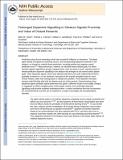Prolonged dopamine signalling in striatum signals proximity and value of distant rewards
Author(s)
Howe, Mark William; Sandberg, Stefan G.; Phillips, Paul E. M.; Graybiel, Ann M.; Tierney, Patrick
DownloadGraybiel_Prolonged dopamine.pdf (717.0Kb)
PUBLISHER_POLICY
Publisher Policy
Article is made available in accordance with the publisher's policy and may be subject to US copyright law. Please refer to the publisher's site for terms of use.
Terms of use
Metadata
Show full item recordAbstract
Predictions about future rewarding events have a powerful influence on behaviour. The phasic spike activity of dopamine-containing neurons, and corresponding dopamine transients in the striatum, are thought to underlie these predictions, encoding positive and negative reward prediction errors. However, many behaviours are directed towards distant goals, for which transient signals may fail to provide sustained drive. Here we report an extended mode of reward-predictive dopamine signalling in the striatum that emerged as rats moved towards distant goals. These dopamine signals, which were detected with fast-scan cyclic voltammetry (FSCV), gradually increased or—in rare instances—decreased as the animals navigated mazes to reach remote rewards, rather than having phasic or steady tonic profiles. These dopamine increases (ramps) scaled flexibly with both the distance and size of the rewards. During learning, these dopamine signals showed spatial preferences for goals in different locations and readily changed in magnitude to reflect changing values of the distant rewards. Such prolonged dopamine signalling could provide sustained motivational drive, a control mechanism that may be important for normal behaviour and that can be impaired in a range of neurologic and neuropsychiatric disorders.
Date issued
2013-08Department
Massachusetts Institute of Technology. Department of Brain and Cognitive Sciences; McGovern Institute for Brain Research at MITJournal
Nature
Publisher
Nature Publishing Group
Citation
Howe, Mark W., Patrick L. Tierney, Stefan G. Sandberg, Paul E. M. Phillips, and Ann M. Graybiel. “Prolonged Dopamine Signalling in Striatum Signals Proximity and Value of Distant Rewards.” Nature 500, no. 7464 (August 4, 2013): 575–579.
Version: Author's final manuscript
ISSN
0028-0836
1476-4687